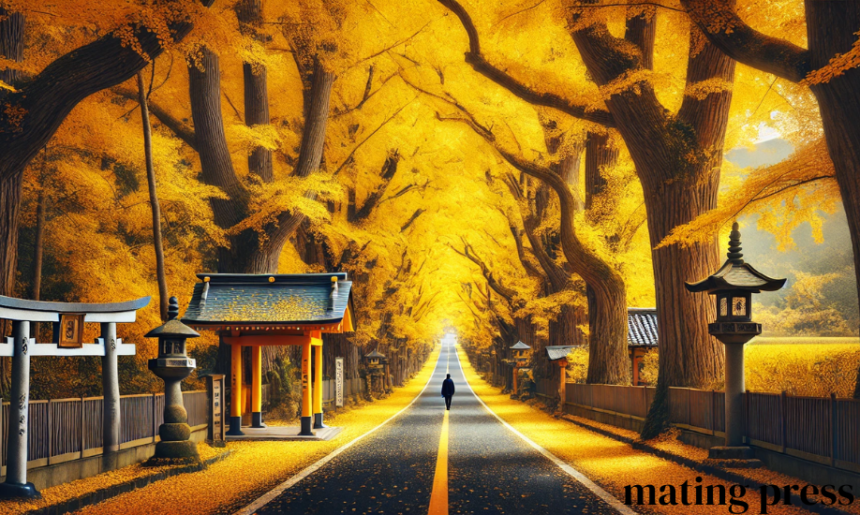Yellow Spring Road in Japan, or “yellow spring road japan,” is one of the country’s most visually captivating and culturally significant destinations. Nestled in Hirokawa, this road is renowned for its stunning seasonal beauty, particularly the golden ginkgo trees that line the path during the autumn months. For travelers seeking an immersive experience of Japanese nature and history, “yellow spring road japan” offers a magical escape into the heart of the country’s natural wonders.
As a frequent topic of exploration for visitors, including those from blog sites like Mating Press, this scenic road holds great appeal for both tourists and locals alike. Let’s dive deeper into the beauty and significance of “yellow spring road japan” through the changing seasons, the cultural experiences it offers, and the best ways to plan your visit.
The Beauty of “Yellow Spring Road Japan” Through the Seasons
One of the key attractions of “yellow spring road japan” is the vibrant transformation it undergoes throughout the year. Each season brings its own unique charm, with autumn being the most celebrated time of year. The ginkgo trees, stretching for nearly 300 meters, turn into a golden tunnel of leaves during late October through early December. This sight alone makes “yellow spring road japan” a must-see destination for photographers, nature lovers, and those simply seeking peace in a serene environment.
During autumn, the rich yellows and oranges of the ginkgo leaves contrast beautifully against the deep blue skies. Walking along “yellow spring road japan” during this time is like stepping into a living painting, with each step cushioned by the fallen leaves. As the leaves cascade from the branches, the air is filled with a sense of tranquility and renewal.
But autumn isn’t the only season to enjoy “yellow spring road japan.” In spring, from late March to early April, cherry blossoms bloom nearby, adding a pink blush to the already picturesque scenery. The juxtaposition of golden ginkgo trees and delicate cherry blossoms makes this road a year-round destination for travelers and locals alike.
Cultural Significance of “Yellow Spring Road Japan”
The cultural roots of “yellow spring road japan” run deep. The ginkgo trees, which are central to its charm, hold a special place in Japanese culture. Ginkgo trees, known for their resilience and longevity, symbolize peace, endurance, and hope for the future. These trees were planted along “yellow spring road japan” as early as the 1900s, standing as living monuments to Japan’s commitment to nature and its peaceful philosophy.
Throughout the year, numerous festivals are held along “yellow spring road japan,” celebrating both the natural beauty of the area and its cultural heritage. One of the most notable is the Ginkgo Festival, held in November during the peak of the autumn foliage. This festival is a vibrant blend of music, traditional dance, and craft workshops, where visitors can immerse themselves in Japanese culture while enjoying the beauty of the golden canopy.
As the ginkgo trees are deeply ingrained in the country’s cultural identity, the road also serves as a reminder of Japan’s relationship with nature. Festivals such as these highlight the importance of preserving natural wonders like “yellow spring road japan” for future generations, a philosophy that resonates with local communities and travelers from blog sites like Mating Press, which encourages appreciation of nature’s wonders.
Best Times to Visit “Yellow Spring Road Japan”
Planning a visit to “yellow spring road japan” requires timing, as different seasons provide distinct experiences. While autumn is the most popular time, due to the stunning golden ginkgo leaves, spring is equally captivating for cherry blossom lovers.
- Autumn (October to December): The peak time to visit “yellow spring road japan” is from late October to early December when the ginkgo trees are in their full golden splendor. During this time, the road is bustling with tourists, photographers, and festival-goers who come to witness the iconic golden tunnel.
- Spring (March to April): In spring, cherry blossoms bloom, offering visitors another opportunity to experience the beauty of the road in a different light. The pale pink blossoms provide a soft, romantic atmosphere that contrasts beautifully with the earlier autumn hues.
- Winter (December to February): Winter transforms “yellow spring road japan” into a serene, snowy landscape, ideal for those seeking solitude and quiet reflection. With fewer visitors, the road becomes a peaceful retreat, and the nearby hot springs offer a perfect way to warm up after exploring the snowy scenery.
- Summer (June to August): While not as popular as the other seasons, summer brings lush greenery to the area. The dense canopy of ginkgo leaves provides shade, making it a great time for leisurely walks or bike rides.
How to Get to “Yellow Spring Road Japan”
“Yellow spring road japan” is easily accessible from nearby cities like Tokyo, making it a convenient destination for a day trip. For those relying on public transport, the nearest train station is Meiji-jingumae Station, which is within walking distance of the road. Alternatively, several bus routes service the area, and parking is available for visitors traveling by car.
If you’re planning a longer stay, there are plenty of accommodations nearby, ranging from traditional Japanese ryokans (inns) to modern hotels. Some ryokans even offer hot springs (onsens), where visitors can relax and soak in the beauty of the area after a day of exploring.
The beauty of “yellow spring road japan” is not only a visual feast but also an ecological treasure. Conservation efforts by local authorities ensure that the road remains pristine for future generations. Measures include regular tree health checks, designated walking paths to protect the flora, and educational programs that promote environmental awareness among visitors.
The local community also plays a crucial role in maintaining the area’s natural beauty. Volunteer groups frequently organize clean-up events, and there are strict regulations against littering, ensuring that “yellow spring road japan” retains its magic for years to come.
Conclusion
In conclusion, “yellow spring road japan” is more than just a scenic path—it is a cultural and natural landmark that represents Japan’s deep connection to nature and history. Whether you visit during the golden autumn months or the cherry blossom-laden spring, the road offers an unforgettable experience for all. Blog sites like Mating Press highlight the importance of such destinations, encouraging travelers to explore the beauty and significance of places like “yellow spring road japan.”
If you’re planning a trip to Japan, make sure to add this remarkable location to your itinerary. The combination of natural beauty, cultural significance, and environmental conservation efforts make “yellow spring road japan” a must-visit destination.





